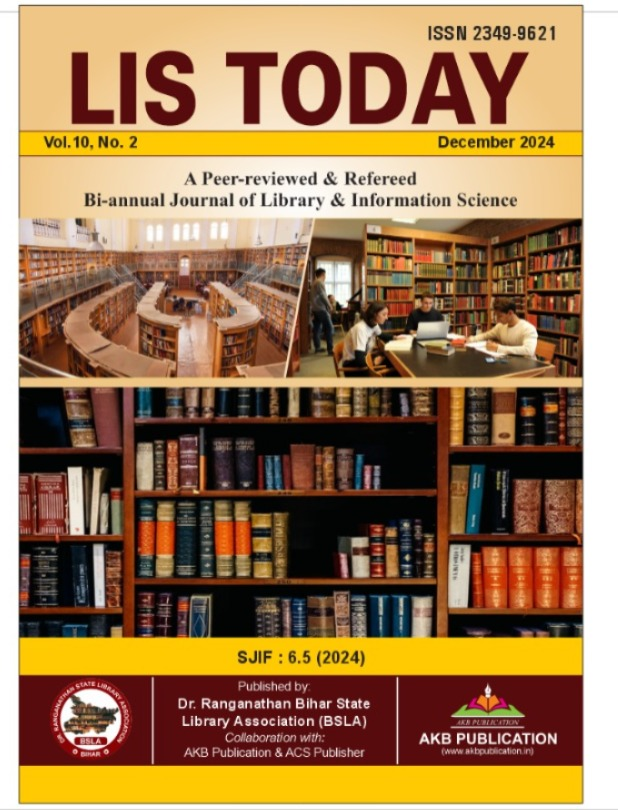Internet Shutdown, Exam Fear and Role of Libraries: A Survey among PG students of Assam University Silchar
Keywords:
Internet Shutdown, Exam Fear, Role of Library, University Library, Assam University SilcharAbstract
The present survey was conducted to find out that how library comes handy in crucial time like shutting of internet by the Government during exam time. Library emerged as a savior for the students. During an internet shutdown, students are barely accessible to the information. Thus this survey reveals that PG students of Assam University prefer to find the resources they find through the internet more easier than the resources available in their library. The shutting down of internet during exam time does leads the students to the psychological phase and thus this phenomenon resulted in fear of failure in exam. The researcher evaluated every perspective of the present study that directly or indirectly related to the PG students of Assam University Silchar about their views on how their library and library professional helps them in internet shutdown during exam time. However, every research has a future scope.
References
[1]. Aouragh, M., & Alexander, A. (2011). The Arab Spring| The Egyptian Experience: Sense and Nonsense of the Internet Revolution. International Journal of Communication, 5(0), 15. Retrieved from https://ijoc.org/index.php/ijoc/article/view/1191
[2]. Arun, C., &Nayak, N. (2016).Preliminary Findings on Online Hate Speech and the Law in India (SSRN Scholarly Paper No. ID 2882238). Rochester, NY: Social Science Research Network. https://doi.org/10.2139/ssrn.2882238
[3]. Chirra, R., &Madhusudhan, M. (2009).Use of electronic journals by doctoral research scholars of Goa University, India.Library Hi Tech News, 26(10), 12–15. https://doi.org/10.1108/07419050911022289 [4]. Ershova, T. V., &Hohlov, Y. E. (2013).Libraries in the Information Society. Walter de Gruyter. Retrieved from https://books.google.co.in/books?hl=en&lr=&id=- WQgAAAAQBAJ&oi=fnd&pg=PA112&dq=%22challenges+and+risks%22+librarians+in+india&ots=xo Tepnp4Qh&sig=QUmvCu28_W2V4s_WKGYvT6wpsd4&redir_esc=y#v=onepage&q=%22challenges%2 0and%20risks%22%20librarians%20in%20india&f=false
[5]. Freyburg, T., &Garbe, L. (2018).Blocking the Bottleneck: Internet Shutdowns and Ownership at Election Times in Sub-Saharan Africa.International Journal of Communication, 12, 3896–3916. Retrieved from http://www.ijoc.org/index.php/ijoc/article/download/8546/2464
[6]. Goothy, S. S. K., Bharath, S., Paladugu, S., Yamalapalli, A. P., Swathi, M., &Penmatsa, G. S. (2019). Effect of pre-exam absenteeism on academic performance among first year BDS students.S. S., 5(2), 4. Retrieved from https://ejournal.manipal.edu/mjnhs/docs/Volume%205_Issue%202/FullPDF/5%20- %20Sai%20shailesh%20%20to%20MUP.pdf
[7]. Graham, M., & Dutton, W. H. (2019).Society and the Internet: How Networks of Information and Communication are Changing Our Lives. Oxford University Press.
[8]. Kawatra, P. S. (1988). Attitudes of research scholars towards the resources and services of three University libraries in Rajasthan (India) – A study.ALIS Vol.35(4) [December 1988]. Retrieved from http://nopr.niscair.res.in/handle/123456789/27826
[9]. Leberknight, C., &Raveendran, N. (2018).Internet Censorship and Economic Impacts: A case study of Internet outages in India. 10. Retrieved from https://pdfs.semanticscholar.org/9ab7/449a70e4c221dd3d46c7002359e443b3634b.pdf
[10]. Map. 1. Study area map of Barak valley (Cachar, Karimganj and... (2016). Retrieved September 8, 2020, from ResearchGate website: https://www.researchgate.net/figure/Study-area-map-of-Barak-valley-Cachar Karimganj-and-Hailakandi-showing-the-location-of_fig1_304783725
[11]. Mohammad, P., &Mohd, S. (2011). Exam phobia-stress management among the students-Indian Journals. Retrieved September 6, 2020, from IndianJournals website: http://www.indianjournals.com/ijor.aspx?target=ijor:eq&volume=2&issue=2&article=010
[12]. Naqvi, T. H. (2012). Use of Electronic Databases by Postgraduage Students and Research Scholars at GBPUAT Library, India. 11. Retrieved from https://www.researchgate.net/profile/Tanveer_Naqvi2/publication/280048973_Use_of_Electronic_Databas es_by_Postgraduage_Students_and_Research_Scholars_at_GBPUAT_Library_India/links/574e771b08aec 988526bcb72.pdf
[13]. Naqvi, T. H. (2014). Use of Collection and Services by P.G. Students and Research Scholars in GBPUAT Library, India.DESIDOC Journal of Library & Information Technology, 34(6), 499–504. https://doi.org/10.14429/djlit.34.6.7938
[14]. Nayak, N. (2018). The Legal Disconnect: An Analysis of India’s Internet Shutdown Laws (SSRN Scholarly Paper No. ID 3254857). Rochester, NY: Social Science Research Network. https://doi.org/10.2139/ssrn.3254857
[15]. Patel, J., Kumar, K., & Krishan, K. (2001).Libraries and Librarianship in India. Greenwood Publishing Group. Retrieved from https://www.google.co.in/books/edition/Libraries_and_Librarianship_in_India/KXVrsPSzeNAC?hl=en&g bpv=1&dq=use+of+university+library+India&printsec=frontcover
[16]. Rhue, L., & Sundararajan, A. (2014).Digital access, political networks and the diffusion of democracy.Social Networks, 36, 40–53. https://doi.org/10.1016/j.socnet.2012.06.007 [17]. Rydzak, J. (2019). Of Blackouts and Bandhs: The Strategy and Structure of Disconnected Protest in India (SSRN Scholarly Paper No. ID 3330413). Rochester, NY: Social Science Research Network. Retrieved from Social Science Research Network website: https://papers.ssrn.com/abstract=3330413 [18]. Saikia, M., &Chandel, A. S. (2013).Use and User’s Satisfaction on Library Resources and Services in Tezpur University (India): A Study (SSRN Scholarly Paper No. ID 3377087). Rochester, NY: Social Science Research Network. https://doi.org/10.2139/ssrn.3377087
[19]. Sandhu, J. (2011). A Burmese Case Study: Far from Inherent – Democracy, and the Internet | The McMaster Journal of Communication. 7(1). Retrieved from https://journals.mcmaster.ca/mjc/article/view/256
[20]. Singh, M., & Arora, A. K. (2015).Library Resources and Services in the Selected University Libraries of Haryana, India.DESIDOC Journal of Library & Information Technology, 35(1), 47–53. https://doi.org/10.14429/djlit.35.1.7967
[21]. Swetaa, Priya, A., &Jothi, A. (2018, November).EBSCOhost | 132173473 | Intensity of stress among exam going students among South Indian population. Retrieved September 6, 2020, from Drug Invention Today website: https://web.b.ebscohost.com/abstract?direct=true&profile=ehost&scope=site&authtype=crawler&jrnl=097
57619&AN=132173473&h=ea8XFOJPlK%2bhnmaqnaEzo3BE0mvGsVfF0g069cdMefIdicriz0a%2bUPC CT54Twy8UeoRmTC6FU%2fKe6zLKWGLNTQ%3d%3d&crl=c&resultNs=AdminWebAuth&resultLoc al=ErrCrlNotAuth&crlhashurl=login.aspx%3fdirect%3dtrue%26profile%3dehost%26scope%3dsite%26au thtype%3dcrawler%26jrnl%3d09757619%26AN%3d132173473
[22]. Thenmozhi, R., Karthikeyan, P., Vijayakumar, V., Keerthana, M., &Amudhavel, J. (2015).Backtracking performance analysis of Internet protocol for DDoS flooding detection.2015 International Conference on Circuits, Power and Computing Technologies [ICCPCT-2015], 1–4. https://doi.org/10.1109/ICCPCT.2015.7159474
[23]. Vargas-Leon, P. (2016). Tracking Internet Shutdown Practices: Democracies and Hybrid Regimes. In F. Musiani, D. L. Cogburn, L. DeNardis, & N. S. Levinson (Eds.), The Turn to Infrastructure in Internet Governance (pp. 167–188). New York: Palgrave Macmillan US. https://doi.org/10.1057/9781137483591_9

